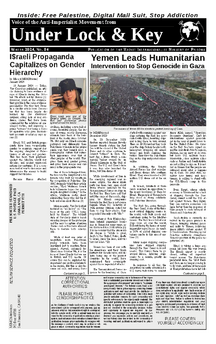
Fighting STG Label for Notes on Political History
I am housed at Suwannee Correctional Close Management Unit, which is the Florida Department of Corruption's equivalent of the SHU or AdSeg. On 4 August 2014, myself and several other political prisoners on my cell block were targeted for repression during a shakedown which was conducted by the pigs. This shakedown was in retaliation for several grievances/complaints being filed about the corrections officers denying us outdoor yard access and indoor day room activities, including access to the phones.
During the shakedown the pigs read some notes I had written down from studying politics, history, and communism. These notes contained some commentary that wasn't very patriotic or friendly toward the Amerikan imperialist regime. When the pigs ordered me to explain the notes I told them that "I like to take notes on politics and current events," and "I like to keep tabs on what's going on in the outside world." The sergeant then held up one of the notes referring to "sovereignty" and said "so you're a sovereign citizen?" To which I replied, "No, I'm just a normal human being." Then he told me to explain why I had notes on weapons. I told him how I was in the U.$. army and developed a fascination for firearms, and he responded by saying, "so now you're a domestic terrorist?" I then told him that the average Amerikan citizen is more likely to be terrorized by their own local law enforcement than by so-called "terrorists."
Myself and three other prisoners were placed in confinement after the shakedown and we were charged with the disciplinary infraction of "Possession of Gang Related Paraphernalia." They tried to validate me as a member of a Security Threat Group (STG) on the basis that in the notes I made a reference to "Popular Sovereignty" and that therefore I was in possession of documents related to the sovereign association, which the imperialist bureaucrats view as a STG because sovereign citizens are not compelled to abide by U.$. laws.
When I went to my disciplinary hearing I told these pigs that the so-called evidence they have against me (the "gang paraphernalia") is merely a bunch of notes I copied from social studies. I explained that "Popular Sovereignty" is (supposed) to be one of the five basic principles of Amerikan government and that anyone who claims to be a patriotic Amerikan citizen should at least know this.
I used this argument to beat this charge and I also presented my own evidence as a defense — part of a social studies assignment on Amerikan government from FDOC's very own educational department which explains (what is supposed to be) the Five Basic Principles of Amerikan Government; 1) Federal System, 2) Popular Sovereignty, 3) Separation of Powers, 4) Checks and Balances, and 5) Limited Government. In real life these "principles" hold no valuable meaning, just as the U.$. constitution is merely a piece of paper.
It seems evident that anyone making an attempt to educate themselves is viewed as a threat by the imperialist bureaucrats and anyone who is against oppression and imperialism is a "domestic terrorist." As revolutionaries, it is imperative that we educate ourselves and our fellow comrades and expose the true terrorists for who they really are: the terrorists in pig clothing, masquerading as those who "protect and serve" and provide "care, custody and control."
We shall prevail in our struggle against imperialist oppression.
MIM(Prisons) adds: We have heard from some comrades that even writing to MIM(Prisons) or participating in our correspondence study groups can be used as evidence for STG validation. We know there is a risk to corresponding and working with MIM(Prisons) but the education and organizing opportunities are great. We hope others will take this comrade's example to fight false validation attempts made against them and stay active in political work and study. For those not yet involved in political study, write to us to join our next introductory study group.





 Alabama
Alabama
 Alaska
Alaska
 Arizona
Arizona
 Arkansas
Arkansas
 Army Post
Army Post
 California
California
 Colorado
Colorado
 Connecticut
Connecticut
 Delaware
Delaware
 District of Columbia
District of Columbia
 Federal
Federal
 Florida
Florida
 Georgia
Georgia
 Guam
Guam
 Hawaii
Hawaii
 Idaho
Idaho
 Illinois
Illinois
 Indiana
Indiana
 Iowa
Iowa
 Kansas
Kansas
 Kentucky
Kentucky
 Louisiana
Louisiana
 Maine
Maine
 Maryland
Maryland
 Massachusetts
Massachusetts
 Michigan
Michigan
 Minnesota
Minnesota
 Mississippi
Mississippi
 Missouri
Missouri
 Montana
Montana
 Nebraska
Nebraska
 Nevada
Nevada
 New Hampshire
New Hampshire
 New Jersey
New Jersey
 New Mexico
New Mexico
 New York
New York
 North Carolina
North Carolina
 North Dakota
North Dakota
 Ohio
Ohio
 Oklahoma
Oklahoma
 Oregon
Oregon
 Pennsylvania
Pennsylvania
 Puerto Rico
Puerto Rico
 Rhode Island
Rhode Island
 South Carolina
South Carolina
 South Dakota
South Dakota
 Tennessee
Tennessee
 Texas
Texas
 Utah
Utah
 Vermont
Vermont
 Virginia
Virginia
 Washington
Washington
 West Virginia
West Virginia
 Wisconsin
Wisconsin
 Wyoming
Wyoming
